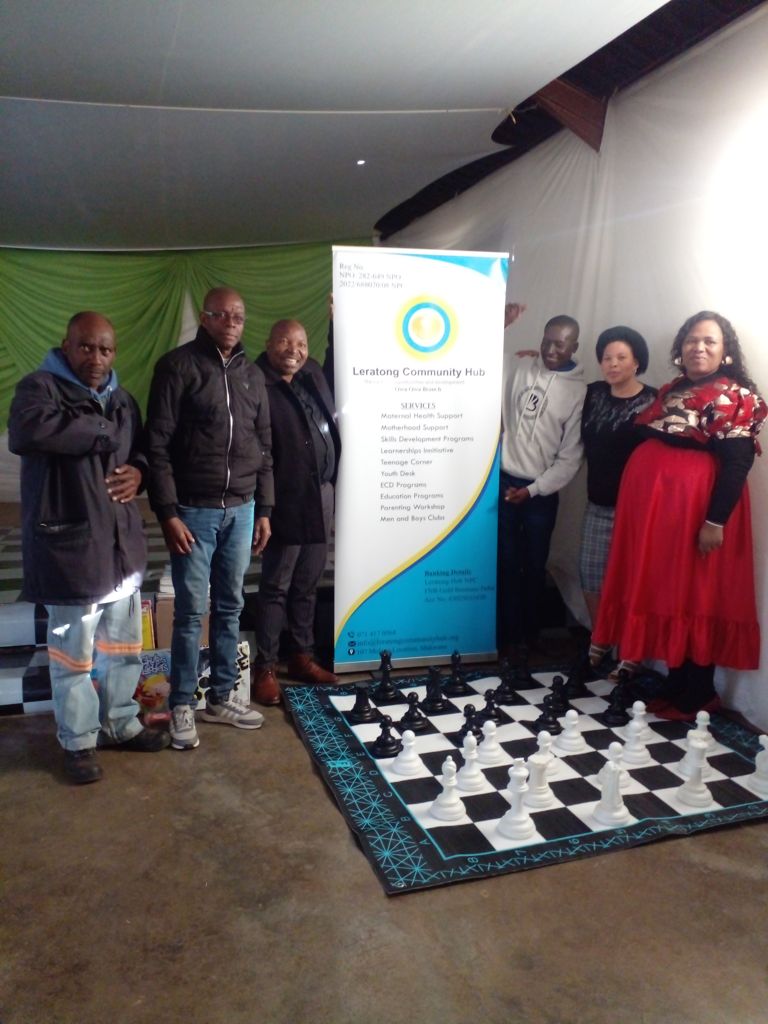Story
By Constance Mcira
Development sponsorship
South Africa
Sasol Foundation Trust
PROJECT OVERVIEW The Community Library and Play Parks Project aims to provide a safe, educational, and recreational space for all community members. The project will focus on establishing a library with a diverse collection of books, STEM, coding, robotics, educational toys and creating play parks that promote physical activity, creativity, and social interaction.
OBJECTIVES Enhance literacy: Provide access to books, educational materials, STEM resources, educational toys and digital resources for people of all ages. Promote physical activity: Establish welldesigned play parks to encourage outdoor play, physical exercise, and social engagement among children. Community development: Foster community engagement through educational programs, reading clubs, playgroups, and social activities in shared spaces. Inclusivity: Design the library and parks to be accessible for people with disabilities.
SCOPE Library Component: Collection of books, magazines, STEM, educational toys and digital resources. Spaces for quiet reading, studying, and group discussions. Educational programs (e.g., story time, book clubs, STEM clubs, coding, robotics sessions, tutoring). Public access to computers and the internet. After-school programs, ECD visits and workshops. Play Park Component: Age-appropriate playground equipment. Safe, durable, and accessible design (including ramps and sensory play areas). Green spaces for relaxation, picnics, and community gatherings. Walking and exercise trails for all age groups.
PROJECT TEAM Project Manager: Oversees planning, budgeting, and execution. Community Coordinators: Engage with community stakeholders for feedback and participation. Core Team: Plan the layout and design of the library and play parks. Community members, SEF, PESP & EPWP programs: Responsible for the physical construction. Library Staff: Manage the operations, including book circulation, programs, and events. Volunteers: Assist in day-to-day tasks, especially during community events and programs.
PROJECT TEAM Project Manager: Oversees planning, budgeting, and execution. Community Coordinators: Engage with community stakeholders for feedback and participation. Core Team: Plan the layout and design of the library and play parks. Community members, SEF, PESP & EPWP programs:
STAKEHOLDERS Local Government: Permits, funding, and ongoing maintenance. Community Members: End-users and contributors to the development. Non-Profit Organizations: Potential collaborators for funding, books, and educational programs. Educational Institutions: Local schools may partner in providing books, volunteers, or program materials. Corporate Sponsors: For financial support, donations of materials, or volunteer programs.
FUNDING Library: Books, digital resources, and materials. Furnishings (tables, chairs, shelves). Computers and IT infrastructure. Salaries for librarians and support staff. Play Parks: Playground equipment (swings, slides, climbing structures). Landscaping and fencing. Maintenance and safety inspection. Funding Sources: Grants from local government and foundations. Corporate sponsorships. Crowdfunding and community fundraising. In-kind donations of books, equipment, and volunteer time.
TIMELINE Phase 1 (3 months): Initial planning, stakeholder engagement, and securing funding. Phase 2 (6 months): Library design, book collection, and program planning; begin construction of the play parks. Phase 3 (3 months): Library setup, hiring staff, program launch, and park completion. Phase 4 (Ongoing): Operation, maintenance, and evaluation of the project’s impact.
RISK MANAGEMENT Funding Shortfalls: Seek multiple sources of funding and ensure strong community engagement. Construction Delays: Plan for contingencies and hire experienced contractors. Safety Concerns: Regular inspections and adhering to safety standards for both the library and parks.
MONITORING & EVALUATION Library Usage: Track the number of visitors, books borrowed, and program participation. Play Park Usage: Monitor community engagement through foot traffic and feedback. Community Impact: Survey community members for feedback and suggestions for improvement.
SUSTAINABILITY PLAN Regular fundraising drives and events to ensure long-term financial support. Community volunteers and partnerships with schools and organizations for ongoing engagement. Environmental sustainability practices such as energy-efficient lighting, recycling programs, and green landscaping. This plan aims to create a thriving, inclusive environment where community members can be a part of their own community development program on different stages of the program by utilizing ABCD( Asset-Based Community Development) methods, to foster growth intellectually, socially, physically and to develop pride and a sense of ownership towards community development.
SCALING COMMUNITY LIBRARIES Modular Library System: Create portable or pop-up libraries that can easily be set up in different communities. Digital Library Network: Build a shared online library system where people can borrow books from different community libraries without needing a lot of physical space. Volunteer-Based Scaling: Train local community members to run small libraries, which lowers staffing costs and gets more people involved. Satellite Libraries: Start small library branches in places like schools or public buildings, and expand them if needed. Partnership Networks: Partner with larger libraries, universities, and companies to get resources, expertise, and used books.
SCALING PLAY PARKS Replication Model: Make a guide for building new parks. Each park should stick to basic principles but be flexible to fit the community's needs, using playground ideas and design handbooks. Public-Private Partnerships: Work with local businesses, non-profits, and the government to share costs and keep the parks running long-term. Franchise Model: Design a flexible park model that other cities or towns can use by getting a license or franchise. Technology Integration: Add smart technology (like smart benches and safety monitors) to improve park efficiency and gather information on how the park is used. Maintenance and Staffing: Create a plan to keep parks well-maintained, either by hiring staff or working with local groups for volunteer-based upkeep.
APPROVED LAND We are honoured to have been allocated a plot of land by the Makoane Traditional Council for the building of the library.
